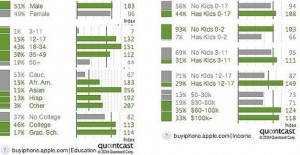One of the most important task of any business is to gain a better understanding of their target audience.
Demographics: A Thing of the Past
 Demographics has been the marketing instrument of defining a target audience for most of the last 100 years. It was an attempt to cluster large groups of people into simple boxes so companies could pitch products and services.
Demographics has been the marketing instrument of defining a target audience for most of the last 100 years. It was an attempt to cluster large groups of people into simple boxes so companies could pitch products and services.
Marketing typically divides groups according to age, gender, ethnicity, income level, etc. These are large segments of the populations that fit a similar characteristic.
During the rise of mass communications like TV and Radio in the boom years of the 50’s and 60’s, the goal was to group people into very specific segments so they could sell advertising.
What Group Are You In?
The idea was that people of the demographic are going to have the same inclination toward products and services, therefore, market to the group.
Marketing was lumping millions of people into the same group and calling them “Baby Boomers” or “Gen-X-ers.” This made it easier to sell stuff, because people in those groups seemed to accept the classification and “own” the identity.
With the advent of the social network and the proliferation of the internet. Groups have become highly segmented. It’s no long a good marketing idea to look at groups in such large demographic memes.
We are Fragments
We have become fragmented. We have begun to migrate into smaller and smaller niches until the larger classifications really become meaningless.
If you operate a business and have defined the scope of your market to be consumers between the age of 34 – 55 with a household income over $100k and who ready online journals weekly, you have identified a market of several million. That is a market that is too large to reach and to diverse to appreciate your goods or services.
Psychographics are the New Thing!
Today, the trend is to look at psychographic profiles. Psychograpics looks at the beliefs, philosophy, attitudes, interst and personalities that effect a consumers tendencies toward products and services.
Instead of looking at the “group” that bought, you look at “why” they bought. A business owner that is able to understand the things that motivate a consumer to purchase, is better able to market to that consumer.
The power of the social network is that we have an opportunity to understand the psychographic of our audience. Instead of defining a group of 17 million consumers that may or may not have any interest in your goods, you can can define a group of 50,000 consumers that are looking for your product or service and are ready to buy.
Look at the profiles of the friends you have on your social graph. Digest the information. What are the common themes? What are their common interest? Who do they follow?
Build deep understanding of your customer, or risk the consequences.
Leave a Reply